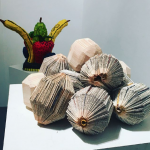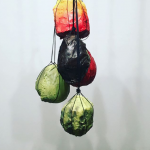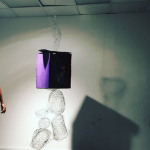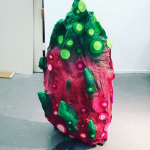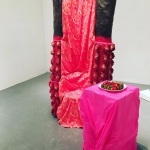Learning Objectives
- Demonstrate an understanding of the visual elements and principles of design.
- Demonstrate an understanding of forming, molding, carving and paper maché manipulation.
- Demonstrate an understanding of color theory.
Important Terminology
Paper Maché – a substance made of pulped paper or paper pulp mixed with glue and other materials or of layers of paper glued and pressed together, molded when moist to form various articles, and becoming hard and strong when dry.
Armature – an internal frame or skeleton which supports a modelled sculpture.
Additive – Is the process by which material is shaped and built up, frequently on an armature, to create the desired image.
Modelling – An additive process in which material is steadily built up to produce the finished figure.
Subtractive – Involves removing material, as in wood carving or stone sculpture, to create a finished work.
Materials
- Chicken wire and / or cardboard (split a roll with another student)
- Hot glue gun and glue sticks
- One bag of flour
- Gallon of white glue (can be split with another student)
- Acrylic latex paint
- Paintbrushes
- Newspaper (lots of it)
- Cheap whisk
- Drywall compound (not DAP)
- Cheap rolls of toilet paper
- Mineral oil (split with several students)
- 5 gallon bucket
- Putty knife
Sketchbook Mini-Assignments
1. Research the artists you were given in class. Do lots of research. Take notes. Watch videos. Look at images. Read their writings. Include this research in your sketchbook.
2. Watch and take notes on the videos linked below.
3. Workout ideas for your major assignment through sketches in your sketchbook.
Project
Using the two artists you chose during class, combine their styles to create a fruit or collection of fruit. You may have to look at several of their works of art to find two pieces that you could pull from. The minimum size is 2 feet.
After extensive sketching, create an armature to act as a support for your sculpture. Using chicken wire or cardboard strips, wrap your armature to create the shape of your fruit. Once you have a shape that works, cover your chicken wire armature with a mixture of wheat paste (flour and water) and torn strips of newspaper. Once this has dried, use additional coats of paper maché to smooth out or add texture to your sculpture. Once the paper maché is fully dry, paint your object. You also need to consider how it will be displayed.
Try to get your paper maché as smooth as possible. You can use drywall compound to lightly cover your sculpture and then once it is dry, sand it smooth. You do not want it to look like strips of paper once you have it painted.
Research
